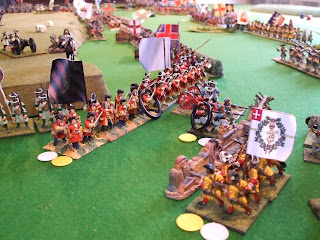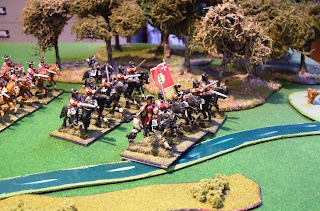The action this week comes from Cromwell's 1650 campaign in Scotland which culminated in the battle of Dunbar. Prior to the decisive battle at Dunbar, Cromwell had twice attempted to draw the Scottish army out of the Edinburgh defences. It was during the second attempt that the action at Gogar was fought. The English forces were reaching ever further westwards, seeking a gap in the Scottish lines to try and establish a position on the Forth from which to strengthen their naval hold on the area.
The English force of three foot regiments, two horse regiments and a regiment of dragoons, augmented by a unit of firelocks and two light guns; faced a scratch defence of two Scottish foot regiments, two horse regiments, a unit of dismounted dragoons, a small unit of 'moss' troopers and some Highland archers. The Scots also had one heavy gun and a frame gun. The defence rested mainly on a redoubt by the village of Gogar. Away to the east (Scots left) the Gogar Burn flowed in broad, shallow, meandering course between steep, muddy banks and marshy fields. To the west low wooded hills made manoeuvre difficult.
The dice decided that I would command the Scots, and I at once began to reposition the reserve. Maclean's Horse moved off to the left, hoping to outflank any attack on the redoubt. Forbes Horse moved to the opposite flank to oppose a threatened attack by the English horse. To my front the were the English foot and the first to advance were Skippon's who moved towards the redoubt. On their right were the firelocks and a Rainsborough's foot regiment; they moved towards my centre pinning my infantry and concentrating their artillery on the pike block holding the road past Gogar .
At first things seemed to be going well. The dragoons were inflicting casulaties on Skippon's infantry and suffering little in return due to the stout breastwork. The light frame gun was adding to the English infantry's discomfiture and just for good measure my snipers were taking pot shots at the officers. Skippon's got within standard range and fired a couple of volleys, but their casualties, particularly amongst the officers lead to them having to fall back to rally. The firelocks were also suffering, being fired on from front and flank; they suffered over 40% casualties before finding a position from which they could exact some revenge, firing volleys at the Scots musketeers supporting the pikes.
The English snipers now took a hand and from a rocky outcrop they fired a shot which picked off the Scots commander. He was carried into Gogar 'Town House' where the local doctor did what he could, but with overall command now removed, each unit's colonel now made their own decisions.
On the English right the cavalry faced Forbes Horse across the river. Pistol shots were exchanged, but to little effect, until Forbes himself took a ball in the elbow. He retired to the rear to have the wound dressed and without orders his men fell back too into the lee of a low mound. The English horse, encouraged, crossed the muddy stream, but, before they could reform, Forbes second squadron appeared on their flank and charged. The melee was confused, the English were on bigger horses and better armoured, but the Scots had the initial impetus. Neither could gain an advantage until the arrival of Forbes with his reformed squadron, when the Scots began to gain the upper hand.
On the opposite flank Maclean's Horse continued on it flank ride. It lost men to fire from the English dragoons, but pressed on, eventually reaching the English rear area.
But it was in the centre where affairs would be decided. The pikes holding the road were coming under sustained fire from the light artillery and the English reserve infantry. As losses mounted the survivors closed the ranks till only a pitiful handful remained. With no officers left it fell to the oldest survivor to decide that they had done all they could and step by step they fell back towards their supports. Seeing the opposition fall back the English reserve advanced and to their left Skippon's surged up the hill towards the redoubt. The dragoons defending the redoubt had by now suffered heavy casualties and struggled to hold the English foot back. The final infantry reserve had been held back to cover the road, but the commanding captain instead led it instead to aid the dragoons.
He was able to do this because the English foot attacking down the road had been targeted by the Scottish artillery and the musket reserve. Packed together on the narrow road between the hill of Gogar and the Gogar Bog they had suffered heavy casualties. To their front they saw Forbes Lancers and Captain Hoffman's 'Mossers', Skippons attack had stalled and Rainsborough's were losing the
musketry battle to their right.
To cap it all Cromwell was heading towards the rear with the cavalry. Maclean's arrival had prompted this move and although they could not stand against the English horse their position was enough to convince Cromwell that a breakthrough at Gogar was not going to happen and he should therefore fall back on Musselburgh.
The Scots had the victory, but losses had been high and they were mighty glad to see the English leave the field.
Oudenarde 1708
1 day ago





















